
Confessions, 1929 E.V.
The story of ‘The Confessions of Aleister Crowley’, which was published in 1929 E.V.
At the bottom is the extract ‘In the Wake of John Symonds's biography’
── Note the two PDF files/ebooks below! ──
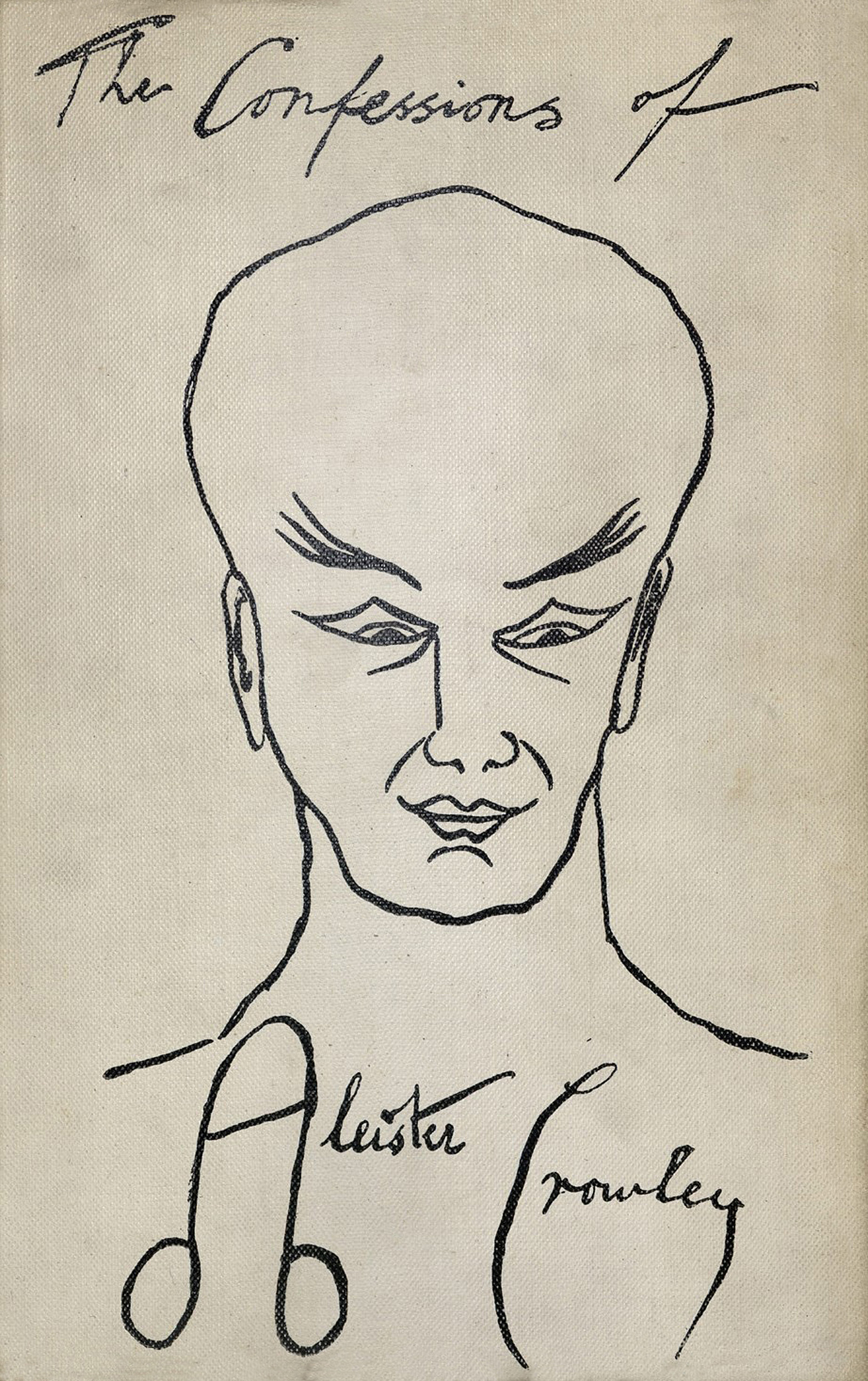
• Front cover of The Confessions of Aleister Crowley (1929 E.V.)
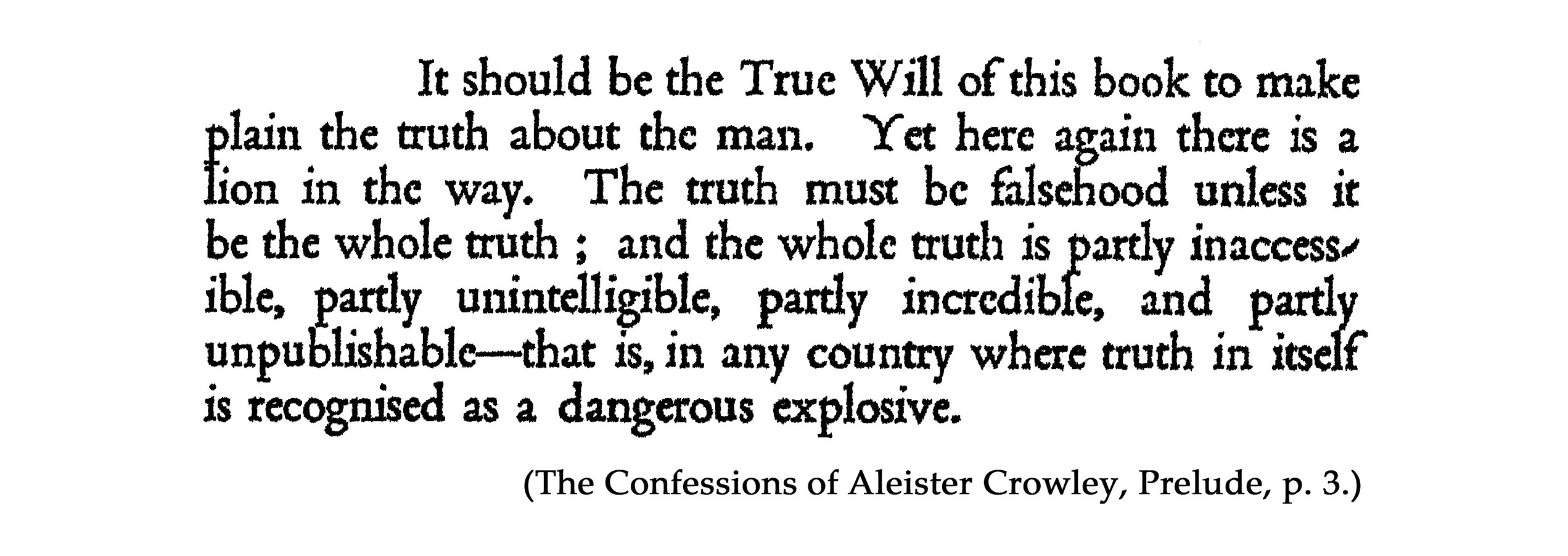

• Read about The Confessions of Aleister Crowley whose first volume was published by The Mandrake Press in November 1929 E.V., and the second volume the month after.
Why did Crowley suddenly stop calling the book "The Hag" and for the first time mentioned it in his Diary as "The Spirit of Solitude"? – Read online or download this PDF file/ebook (51 pp.) containing an extract from FOR THE THELEMITES. [May need further proof reading]
(In connection with this extract, see also the extract "Dec. 5, 1947 E.V."!)
Corrected Version. Read online or download (Acrobat 9.0 and later):
⁂
“ALEISTER ST. EDWARD CROWLEY”
Most people will probably think that the designation “Saint” used by Aleister Crowley dates from his joining of the Ordo Templi Orientis, however, that is not the case!
In the prospectus of “The Confessions of Aleister Crowley” – “The Spirit of Solitude” – issued in the Autumn 1929 E.V., the work’s publisher, and Crowley's friend, P. R. Stephensen of the Mandrake Press in London, had contributed a short essay titled “Is Aleister Crowley a Saint?”, and whose last lines stated:
Is Aleister Crowley a saint? Readers of his Confessions will be able to judge for themselves. And whatever their conclusions, they will not deny the tremendous energy and versatility of the man, or that he is a subtle and unique personality who has lived colourfully in our drab age.
Eleven years before, in New York City in 1918 E.V., Crowley had added “St.” between “Aleister” and “Edward” when he gave his full name to an assistant to the Attorney General who examined him: “Aleister St. Edward Crowley”.
However, the earliest use of “Aleister St. Edward Crowley” that I have seen dates as far back as 1900 where an entry of “Crowley, St. Edward Aleister” in The Literary Year-book And Bookman's Directory 1900 listed the three books, Jephthat, and Other Mysteries [1899]; The Tale of Archais [1898]; and Jezebel, and other Tragic Poems [1898]! – The ultra-rare Jezebel (a total of 52 copies printed) was distributed by Kegan Paul, and priced 15s. net.
In July 1904 E.V. we find the name “Aleister St. Edward MacGregor Crowley” on Nuith Ma Ahathoor Hecate Sappho Jezebel Lilith Crowley’s Birth Certificate, and added to the former name was “Boleskine Khan commonly known as Lord Boleskine, Author”. Rose and Aleister Crowley’s daughter was born on July 28th at Boleskine House after the couple's return from Egypt.
Two years later, in 1906 E.V., "St." also appeared on the birth certificate of Lola Zaza Crowley (born on December 2, 1906 E.V.), where the father’s name stated: “St Edward Aleister Crowley”, information supplied by the mother, Rose Edith Crowley!
Returning to America and WW1, in 1917 E.V. and 1918 E.V. approximately 24 million men living in the United States of America completed a World War 1 draft registration card, thus also Aleister Crowley who on September 12, 1918 E.V., signed his registration card: “Aleister Saint Edward Crowley” (the ‘A’ of "Aleister" phallus-shaped!), and gave his present occupation as a “Poet”!
(Extract from For the Thelemites, but here printed without notes indicating sources etc., which are found in the PDF file/ebook.)

• Aleister Crowley’s painting “MAY MORN” from the ‘Blue’ Equinox (Vol. III., No. I.) which was published in America at the Vernal Equinox in 1919 E.V.
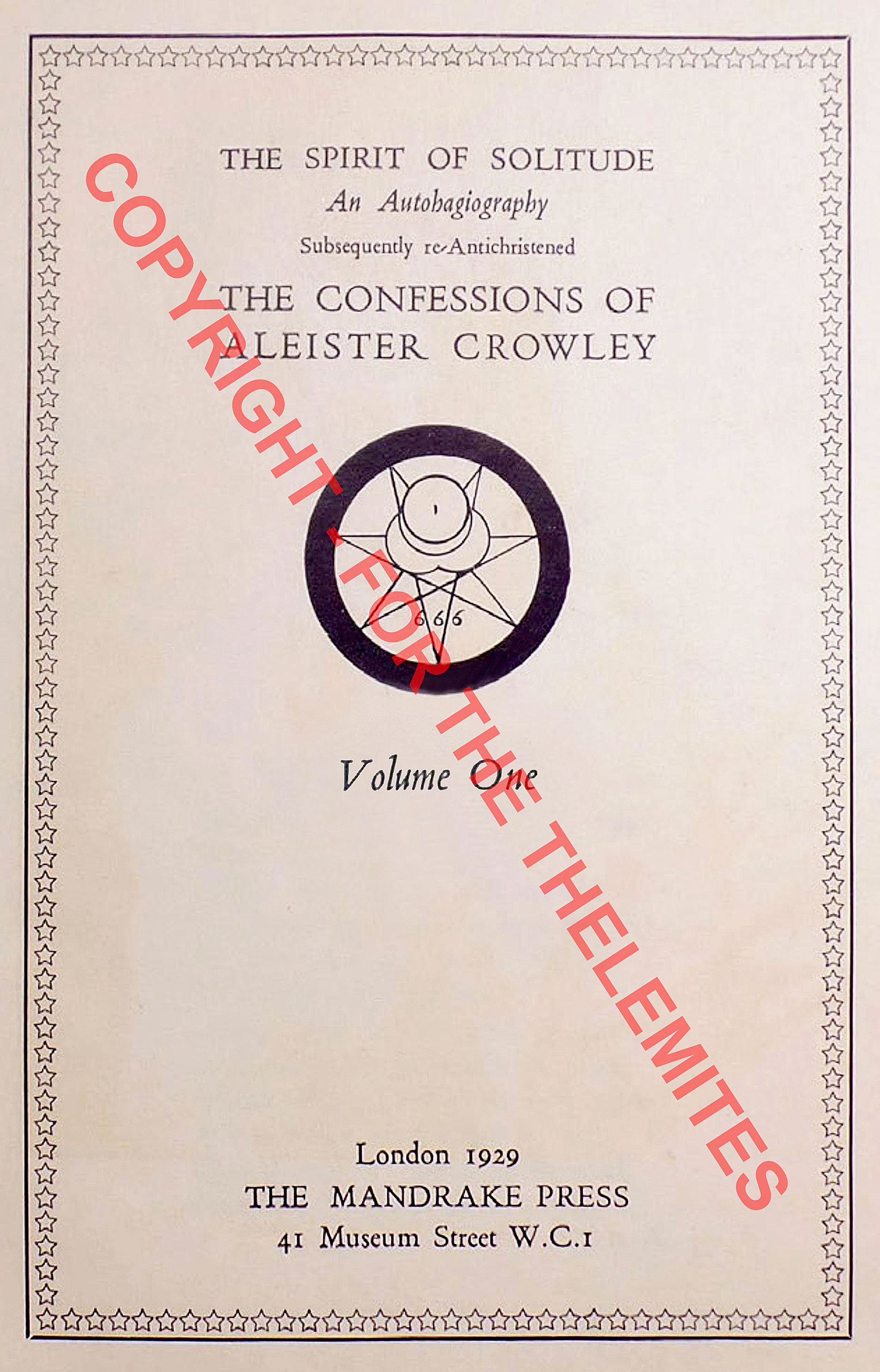
• Title page of the first volume of The Confessions of Aleister Crowley (Published in November, 1929 E.V.)
⁂
‘A FORGOTTEN CASE’
In the summer of 1930 E.V. Aleister Crowley had tried to exhibit his paintings in London, but it came to nothing. However, it turns out that Crowley for the exhibition had hired a photographer to copy a pencil portrait of him drawn by Augustus John – apparently the portrait that appeared as frontispiece in the seventh number of The Equinox, March 1912 E.V. (below). But the photographer did not deliver, and Crowley sued him, as narrated by the London Daily Herald on August 1, 1930 E.V., in a notice headed “AUTHOR’S PORTRAIT” – “JOHN DRAWING THAT WAS KEPT TOO LONG”:
A pencil portrait by Mr. Augustus John, R.A., valued at £100, was the subject of an action at Westminster County Court yesterday.
Mr. Alistair [sic] Crowley, of Park-mansions, Knightsbridge, S.W., sued Mr. J. W. Maycock, a photographer, of Maiden-lane, for the value of the portrait or its return, and damages for its detention.
Mr. C. Gallop, for Mr. Crowley, said the plaintiff was an author, and a portrait of himself in pencil was to be used in connection with an exhibition.
The picture had been returned, and it was a question of costs and whether there was wrongful detention.
Mr. J. R. O. Jones, for the defence, said there was no question of illegal detention. The portrait, with other pictures, had been removed to Mr. Maycock’s studio at Mr. Crowley’s request to be copied.
Judge Sir Alfred Tobin found that there was undue delay in returning the portrait and entered judgment for Mr. Crowley for costs.
Perhaps the portrait together with some of Crowley’s works were illustrations for an exhibition catalogue.
The same day that the notice appeared in the Daily Herald Crowley departed for Berlin together with some 160 of his paintings and drawings. Some of these works (73) were exhibited in October 1931 E.V. at the Gallery Neumann-Nierendorf (Porza) in Berlin – the exhibition opened on October 11, 1931 E.V., and had according to the exhibition catalogue no drawing/photo of a portrait of Aleister Crowley by Augustus John. [Ausstellung Aleister Crowley: vom 11. Oktober bis 5. November 1931 in den Ausstellungsräumen der Porza, Landeszentrale für Deutschland E.V., Berlin W 62, Budapester Strasse 3 / Galerie Neumann-Nierendorf. Berlin W 35 und Porza. Berlin, 1931.]
⁕
The mentioned 1930 E.V. exhibition of Crowley’s paintings was apparently the short-lived exhibition at the Aquila Press in London, or a planned exhibition at Langham Chambers. In 1930 E.V. Crowley had tried to buy the newly founded Aquila Press in London which was for sale. Aquila Press, located at Lenthall Place, Gloucester Road in Kensington, had been founded in January 1929 E.V. by the English publisher, printer and art journalist, and later art gallery director Winifred (Ellen) Henderson, née Lester (1896-1976), known as Wyn Henderson. Wyn Henderson would later write in a memory of Nancy (Clara) Cunard (1896-1965), English poet, publisher and political activist, about Aleister Crowley and his attempt to buy the press:
I can see her [Nancy Cunard] now with her delicate shapely head, rolling her pretty blue eyes with the mischievous expression of a naughty child she so often assumed, in this instance at the sight of the atrocious and horrifying paintings by Aleister Crowley with which he had temporarily plastered the walls of the press he had in vain hoped to buying. Her keen visual sense was very properly outraged but not at the expense of her lively sense of humour.
A couple of years before World War 2 started Wyn Henderson ran gallery Guggenheim Jeune, 30 Cork Street, London W. 1, for the American art collector and bohemian Marguerite "Peggy" Guggenheim (1898-1979).
(Extract from For the Thelemites, but here printed without notes indicating sources etc., which are found in the PDF file/ebook.)
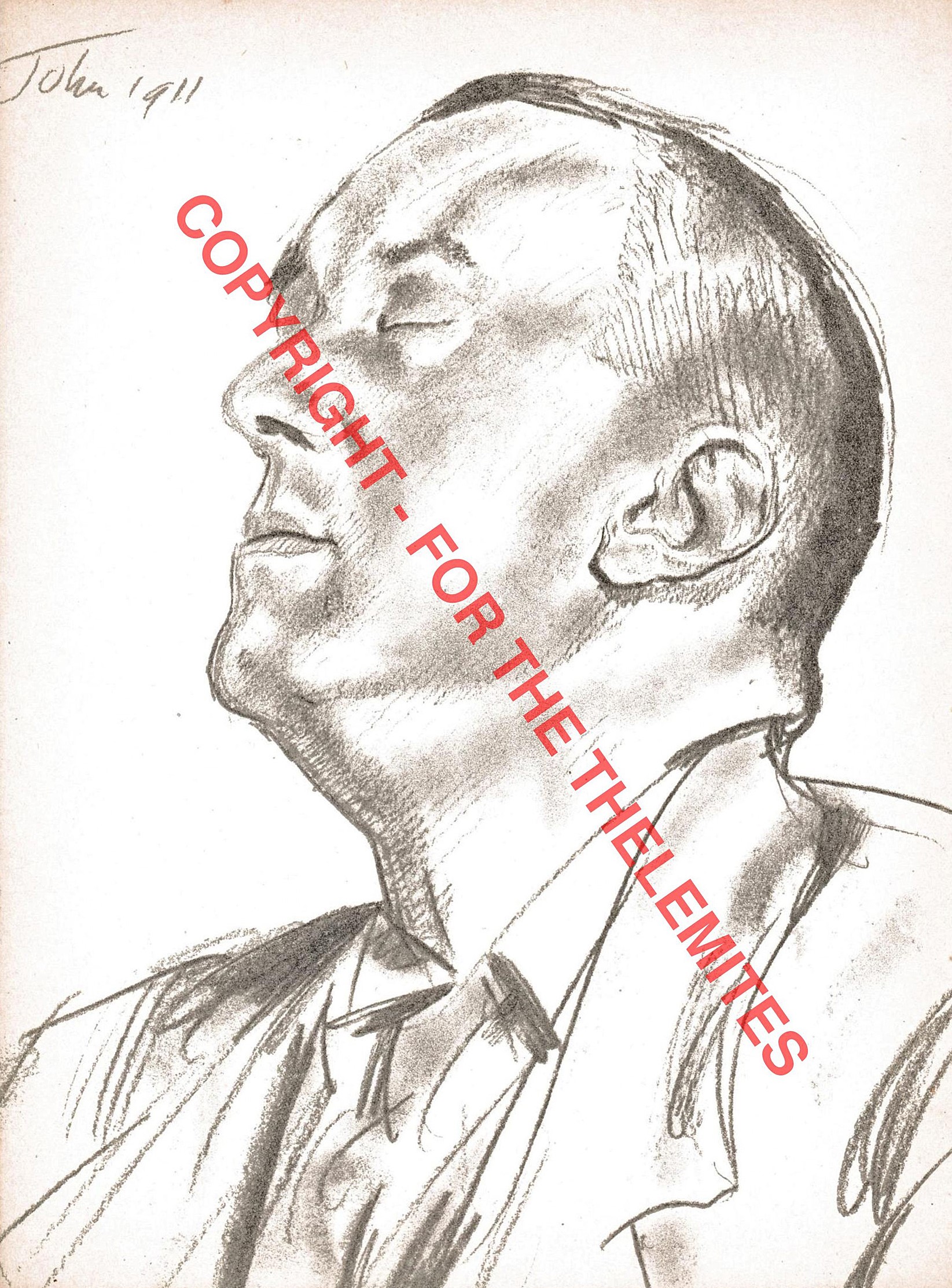
• ‘Aleister Crowley. A Lithograph by Auguste Clot from the Sketch made by Augustus John.’ Frontispiece of the seventh number of The Equinox, March 1912 E.V. The lithograph was also used on the front page of the prospectus of The Confessions of Aleister Crowley, which was issued in the Autumn of 1929 E.V. Augustus John's original pencil drawing "Alistair [sic, Aleister] Crowley in a Trance, 1911," which measures 16 × 10 3/8 inches (40.64 × 26.35 cm), is today in the Albright-Knox Art Gallery, Buffalo, New York, a drawing received in 1953 E.V. as a gift of Anson Conger Goodyear (1877-1969), a Bufallo local business man, military officer, author and collector of modern paintings, rare books and historical manuscripts. A. Conger Goodyear was a director, 1911 E.V., of the Albright Art Gallery in Bufallo, and a founder and president, 1929-39 E.V., of the Museum of Modern Art in New York City. The drawing was originally in the collection of the Irish-American New York lawyer, collector, and patron John Quinn (1870-1924). However, John Quinn must have sold the Augustus John drawing of Crowley before his death in 1924 E.V., since the drawing not is listed in the catalogue John Quinn 1870-1925; Collection of Paintings, Water Colors; Drawings & Sculpture – a catalogue that was published in 1926 E.V. Among the many works of Augustus John appearing in this catalogue is a drawing with the title: ““Portrait of a Poet,” 19½ × 16 in.”, however, the size of this drawing shows that it is not the one in question, which measures 16 × 10⅜ inches, and none of the other drawings have these measures. [John Quinn 1870-1925; Collection of Paintings, Water Colors; Drawings & Sculpture. Huntington, NY: Pidgeon Hill Press, 1926, pp. 18-9.] Augustus John apparently made two drawings of Aleister Crowley in 1911 E.V. The other one, which originally was exhibited in London in December 1911 E.V., is now at the Harvard Art Museums/Fogg Museum in Cambridge, Massachusetts. For the latter, see the page “Amphora”. The drawing that appeared in the seventh number of The Equinox was clearly Crowley’s favourite Augustus John portrait of him – there are four known portraits of Aleister Crowley drawn by Augustus John, the three of them are apparently from the 1910s, and the last one dates from shortly before Crowley’s death and appeared in OLLA in 1946 E.V.
(Extract from For the Thelemites, but here printed without notes indicating sources etc., which are found in the PDF/ebook.)
⁂
Aleister Crowley’s old enemy the rag John Bull – still owned by Odhams Press Ltd. and directed by Julius Salter Elias, 1st Viscount Southwood – published on July 26, 1930 E.V., under the heading “The WORST MAN in BRITAIN” the following garbage about Crowley’s art exhibition in London:
The WORST MAN in BRITAIN
An exhibition of most unpleasant pictures will be on view in London shortly.
They are the sinister works of Aleister Crowley, a self-confessed super-degenerate who, since we exposed him years ago, has been keeping very much in the background.
Dope-friend, devil-doctor and disciple of “black magic,” he is back again in England, after having been deported from many countries.
Crowley, although he can only be interviewed by appointment, has since his arrival in London been using three addresses – at Yeoman House, Hay-market, S.W.; at All Souls’ Place, W.; and at Park Mansions, Knightsbridge, S.W.
Degrading pictures
We have before us as we write photographic copies of some of the “work of art” which Crowley intends to hang for the pleasure of the degenerates and the dupes.
There are grotesque impressions of women for which he would be lynched in certain parts of the Empire.
His own face – the face of “Beast 666,” as he calls himself – is prominently featured, bloated and coarse.
Our present warning is all the more real and urgent since we know that Crowley, for once in a way, is financially embarrassed.
Crowley knows only one way of making money – the corruption of manhood and womanhood.
We will not again stress in detail his record.
Our readers will recollect our many exposures of his “black magic,” his dope carnivals, of how he was banished from France and Italy, of how he was driven from his free love “temple” in Sicily.
Mystic writings
But we consider it our duty to expose this new Crowley menace – the “art” exhibition; not so much the exhibition itself, but the incidentals that will, if not prevented, surrounds it.
When Crowley is engaged in his despicable business, as he is now, scores are in peril.
Young undergraduates and impressionable women are particularly at his mercy.
His insatiable greed will bleed from them every penny of their money if they are seduced by his wiles. […]
(John Bull. London, England: Odhams Press Ltd. ♦ Saturday, July 26, 1930, p. 10.)
That it is stated that John Bull had “photographic copies” of some of Crowley’s pictures suggest that the photographer J. W. Maycock, mentioned above, in all probability must have contacted the journal shortly before the action! As to photographer J.(ames) W.(illiam) Maycock, he was in fact Labour candidate for Ealing, and stood unsuccessfully for the Labour Party for election to parliament at the general elections in 1929 E.V. and 1931 E.V., however, he later became Mayor of Richmond (Surrey) from 1936-37 E.V., and was also Chairman of the Richmond Trades and Labour Council.
(Extract from For the Thelemites, but here printed without notes indicating sources etc., which are found in the PDF file/ebook.)
⁂
IN THE WAKE OF JOHN SYMONDS'S BIOGRAPHY.
• Read, among other things, about people who used John Symonds’s 1951 E.V. biography The Great Beast: The Life of Aleister Crowley in their writings, and also about Somerset Maugham’s novel The Magician, and its later appearance as a silent movie.
This extract from For the Thelemites begins where the above extract "Confessions, 1929 E.V." ends!
– Read online or download this PDF file/ebook (25 pp.) containing an extract from FOR THE THELEMITES. [May need further proof reading]
(In connection with this extract, see also the extract " Confessions, 1929 E.V. "!)
Corrected Version – Read online or download (Acrobat 9.0 and later):
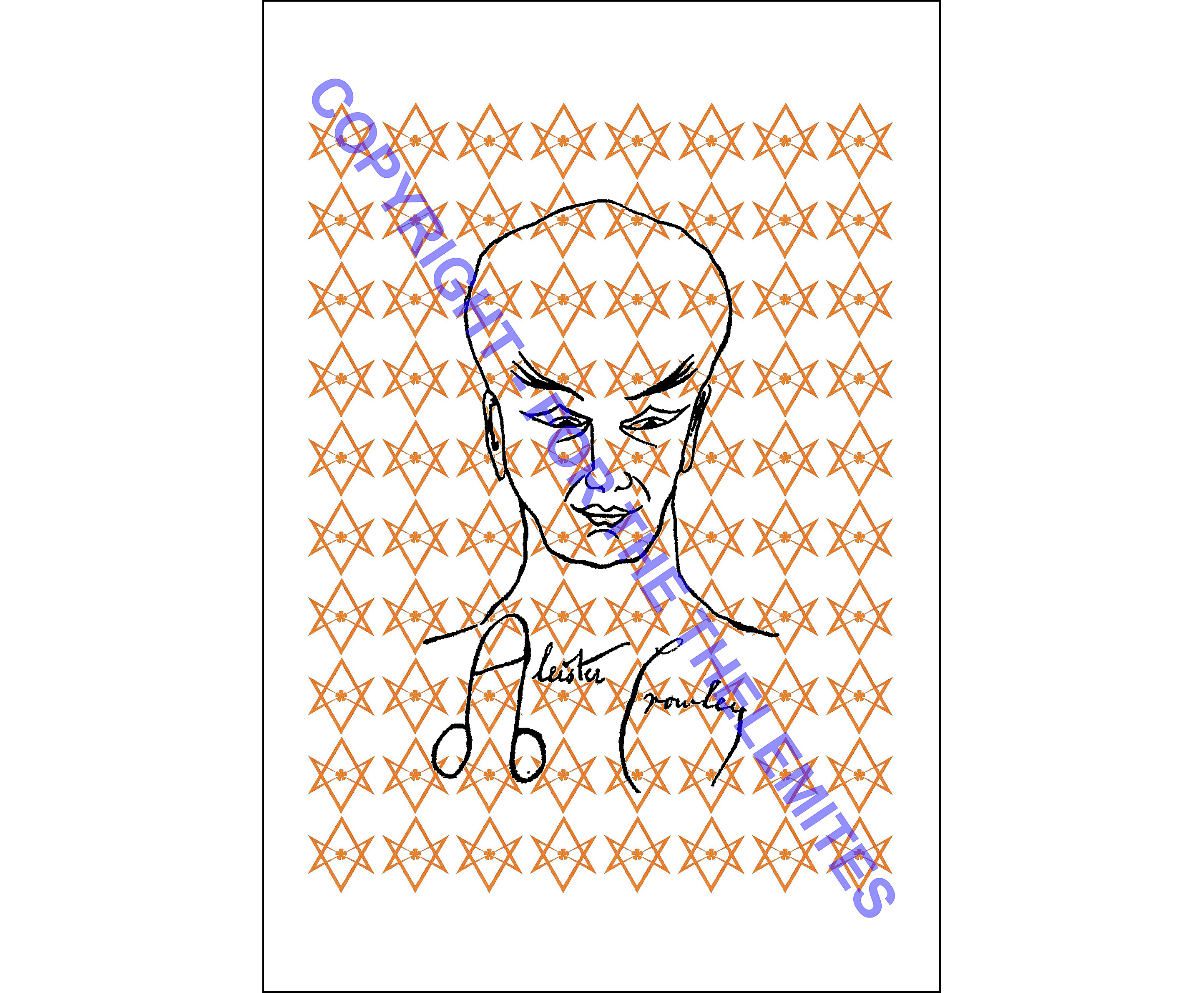
The Word of the Law is θελημα – Do what thou wilt shall be the whole of the Law
Φ
Copyright © Perdurabo ST — All Rights Reserved 2026 E.V.